
JOURNAL OF RUSSIAN LASER RESEARCH
Scope & Guideline
Advancing Knowledge in Atomic and Molecular Physics
Introduction
Aims and Scopes
- Laser Physics and Engineering:
The journal emphasizes research on the fundamental principles of laser physics, including the development of new laser systems, techniques for laser generation, and the engineering of optical components. - Quantum Optics and Information:
A significant area of focus includes the study of quantum states of light, quantum entanglement, and their applications in quantum communication and computing, reflecting the journal's commitment to advancing quantum technologies. - Material Science and Nanotechnology:
Research related to the interaction of lasers with materials, including the fabrication and characterization of nanostructures and the development of novel materials for laser applications, is a core aspect of the journal. - Laser Applications in Industry and Medicine:
The journal publishes works that explore practical applications of laser technology, including but not limited to laser machining, medical laser applications, and environmental monitoring. - Nonlinear Optics and Photonics:
Studies on nonlinear optical phenomena and their applications in photonics, including laser-induced processes and advanced imaging techniques, are prominent in the journal's scope. - Optical Measurement and Sensing Technologies:
The journal covers advancements in optical measurement techniques and sensors, including novel approaches for detecting and analyzing physical and chemical properties using laser technology.
Trending and Emerging
- Quantum Technologies and Quantum Computing:
There is a significant increase in research related to quantum optics, including quantum entanglement and quantum information processing, emphasizing the journal's alignment with cutting-edge technological advancements. - Nanophotonics and Metamaterials:
Research focusing on the development and application of nanophotonic structures and metamaterials is on the rise, highlighting innovative approaches to manipulate light at the nanoscale. - Laser-Based Environmental Monitoring:
Emerging studies on the use of laser technology for environmental applications, including pollution detection and climate monitoring, reflect growing societal concerns and technological applications. - Adaptive and Smart Laser Systems:
Publications on adaptive laser systems that can dynamically adjust to varying conditions are becoming more prevalent, indicating a trend towards more intelligent and responsive laser technologies. - Laser Applications in Biomedicine:
An increasing number of studies are focusing on the biomedical applications of lasers, including laser surgery and diagnostic techniques, reflecting a growing intersection between laser technology and healthcare.
Declining or Waning
- Traditional Laser Materials:
Research focusing solely on conventional laser materials has been decreasing as more emphasis is placed on innovative materials and nanostructures that enhance laser performance. - Basic Laser Theory and Classical Models:
There is a noted decline in publications that delve into classical models of laser operation, as the field moves towards more complex quantum mechanical treatments and applications. - Static Laser Applications:
Papers exploring static or conventional applications of lasers are less frequent, with a shift towards dynamic and adaptive laser systems that incorporate advanced technologies. - Laser Safety Protocols and Standards:
While still important, papers specifically addressing safety protocols and standards in laser usage have become less frequent as the field matures and standards become more established. - Basic Laser Calibration Techniques:
The focus on fundamental calibration techniques for laser systems has waned as advancements in technology and automation streamline these processes.
Similar Journals

APPLIED OPTICS
Driving Progress in Optical TechnologiesApplied Optics, published by Optica Publishing Group, is a prestigious journal dedicated to the field of optics and photonics. With an ISSN of 1559-128X and an E-ISSN of 2155-3165, this journal serves as a critical platform for researchers, professionals, and students eager to disseminate innovative findings and advancements in applied optics. Established in 1962, it has maintained a significant presence in the academic community, currently holding a Q2 category ranking in various disciplines including Atomic and Molecular Physics, Electrical and Electronic Engineering, and Miscellaneous Engineering as per the 2023 metrics. The journal's reputation is underscored by its solid Scopus rankings, attesting to its influential research output. While not an open-access journal, it continues to offer vital insights and discussions on the latest research topics that are critical to the advancement of technologies in optics, ensuring accessibility to vital knowledge for those within the field.
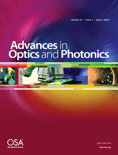
Advances in Optics and Photonics
Exploring the Frontiers of Optics and PhotonicsAdvances in Optics and Photonics, published by the Optica Publishing Group, stands at the forefront of research dissemination in the fields of Atomic and Molecular Physics and Optics, alongside its prominence in Water Science and Technology. With an impressive Q1 ranking in both categories and a Scopus rank of #2/224, this journal boasts a 99th percentile status, underscoring its significance in the academic community. As a beacon of knowledge since its inception in 2009, the journal is dedicated to featuring cutting-edge research, innovative methodologies, and transformative applications in optics and photonics that can drive advancements across diverse scientific domains. While not an open-access journal, it provides vital insights for researchers, professionals, and students eager to stay updated on emerging trends and breakthroughs. With a convergence period extending to 2024, Advances in Optics and Photonics is positioned as an essential resource for anyone looking to explore the evolving landscape of light-based technologies.

Chinese Optics
Empowering Scholars to Illuminate the Future of Optics.Chinese Optics is a premier journal dedicated to advancing the field of optics, encompassing research on atomic and molecular physics. Published by the esteemed Changchun Institute of Optics Fine Mechanics & Physics in China, this journal supports the sharing of cutting-edge findings since its inception in 2010. With an ISSN of 2097-1842, it operates within a competitive landscape, currently positioned in Q3 of the category for Atomic and Molecular Physics and Optics, according to the 2023 metrics. While the journal is not open access, it offers a valuable platform for researchers, professionals, and students to explore and contribute to significant discoveries in the realm of optics and light technology. By fostering scholarly communication, Chinese Optics plays a crucial role in bridging theoretical and practical aspects, making it an indispensable resource for those passionate about the optical sciences.
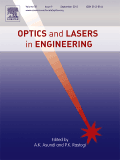
OPTICS AND LASERS IN ENGINEERING
Exploring the Intersection of Light and EngineeringOPTICS AND LASERS IN ENGINEERING, published by Elsevier Science Ltd, is a premier journal dedicated to advancing the field of optics and laser technology in engineering applications. With a robust ISSN of 0143-8166 and E-ISSN 1873-0302, this journal is positioned within the top quartile (Q1) across several categories, including Atomic and Molecular Physics, Electrical Engineering, and Mechanical Engineering as of 2023, showcasing its prestige and impact in the scientific community. The journal has consistently ranked high in Scopus, notably within the top 10% for Mechanical Engineering and Electronic, Optical, and Magnetic Materials research. Since its inception in 1980, OPTICS AND LASERS IN ENGINEERING has served as a vital platform for disseminating cutting-edge research, fostering innovation and collaboration among researchers, professionals, and academia. Though it does not currently offer Open Access options, its high impact factor and selective publication process ensure that articles reach a wide audience while maintaining rigorous academic standards. Researchers and students alike are encouraged to engage with this influential journal to contribute to and stay abreast of advancements in optical technologies and their engineering applications.
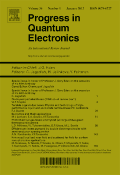
PROGRESS IN QUANTUM ELECTRONICS
Driving Progress in Atomic and Molecular PhysicsPROGRESS IN QUANTUM ELECTRONICS, published by PERGAMON-ELSEVIER SCIENCE LTD, is a premier international journal that serves as a critical forum for the dissemination of high-quality research in the fields of atomic and molecular physics, electrical engineering, and materials science. With its esteemed Q1 category ranking in several disciplines, including Atomic and Molecular Physics, Electrical and Electronic Engineering, and Electronic, Optical and Magnetic Materials, this journal commands a high impact factor and is recognized for its rigorous peer-review process. Established in 1969 and evolving through various phases, the journal currently compiles cutting-edge research that drives advancements in quantum technologies. Researchers, professionals, and students alike are invited to explore a wealth of knowledge and stay updated on pioneering developments in quantum electronics, enhancing their understanding and contributing to the progression of this dynamic field.

ACTA OPTICA SINICA
Connecting Scholars in the World of OpticsACTA OPTICA SINICA is a distinguished journal dedicated to the field of optics and photonics, published by the Chinese Laser Press. With an ISSN of 0253-2239, this journal has been an essential resource since its inception, covering significant discoveries and advancements in atomic and molecular physics, electronic materials, and optical sciences. The journal is indexed in Scopus, achieving respectable ranks as Q3 in both Atomic and Molecular Physics, and Optics and Electronic, Optical and Magnetic Materials, reflecting its engagement with current research trends. Although it is not an open-access journal, ACTA OPTICA SINICA is hosted from Shanghai, China, and continues to serve as a vital platform for researchers, professionals, and students alike to disseminate and access high-quality peer-reviewed articles, ensuring its prominent place in the academic discourse related to optics and material sciences.

LASER PHYSICS LETTERS
Fostering Excellence in Laser ScienceLASER PHYSICS LETTERS is a prestigious peer-reviewed journal published by IOP Publishing Ltd in the United Kingdom, focusing on the burgeoning field of laser physics and its applications. With an ISSN of 1612-2011 and an E-ISSN of 1612-202X, this journal stands at the intersection of innovative research and practical applications, addressing diverse topics within the realms of Instrumentation and Physics and Astronomy. Recognized for its impactful contributions, it boasts a ranking within the Q3 quartile for both relevant categories as of 2023, reflecting its steady rise and commitment to advancing knowledge in the area. Researchers and practitioners are encouraged to explore its content and contribute to the ongoing discourse that shapes the future of laser technologies. While LASER PHYSICS LETTERS does not currently offer open access options, its rigorous selection criteria ensure that published work is of the highest quality, positioning it as a vital resource for anyone engaged in laser science and engineering.

Journal of Optics-India
Advancing the Frontiers of Optical ScienceThe Journal of Optics-India, published by SPRINGER INDIA, serves as a vital platform dedicated to advancing research in the field of optics, focusing on topics in both atomic and molecular physics. With an ISSN of 0972-8821 and an E-ISSN of 0974-6900, the journal has been a consistent contributor to the field since its inception in 1996 and continues to thrive with its anticipated convergence through 2024. Although currently classified in Q3 of the 2023 category quartiles, the journal actively seeks to elevate its standing within Scopus rankings in physics and astronomy, where it holds a rank of 143/224, indicating significant opportunities for growth and research impact. The Journal of Optics-India is committed to fostering innovative research and providing scholars and practitioners with access to cutting-edge findings, thereby enhancing global conversations around optics and its vast applications. As a reliable source for researchers, professionals, and students alike, the journal emphasizes quality contributions that shape the future of optical science.
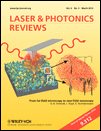
Laser & Photonics Reviews
Pioneering Insights in Atomic and Molecular PhysicsLaser & Photonics Reviews is a prestigious academic journal published by WILEY-V C H VERLAG GMBH, based in Germany. Since its inception in 2007, the journal has rapidly established itself as a leading outlet in the fields of Atomic and Molecular Physics, Condensed Matter Physics, and Electronic, Optical, and Magnetic Materials. With its impressive impact factor and presence in the Q1 category across multiple relevant disciplines, it ranks among the top-tier journals in its field—ranked #18 out of 434 in Condensed Matter Physics and #13 out of 224 in Atomic and Molecular Physics according to Scopus rankings. The journal emphasizes high-quality research that contributes significantly to theoretical and applied photonics, bridging gaps between fundamental science and practical applications. Although access is not open, it remains essential reading for researchers, professionals, and students eager to stay abreast of groundbreaking advances and applications in laser technology and photonics. For further information and to explore its compelling articles, please visit its official site.
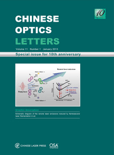
Chinese Optics Letters
Catalyzing collaboration in optical science.Chinese Optics Letters is a prestigious academic journal published by Chinese Laser Press, dedicated to advancing the fields of atomic and molecular physics, optics, as well as electrical and electronic engineering. Since its inception in 2003, this journal has become a significant platform for researchers and professionals to disseminate innovative findings and foster collaboration within these rapidly evolving disciplines. With a commendable Q2 ranking in leading categories including Atomic and Molecular Physics and Electronic, Optical and Magnetic Materials, it ranks favorably within the Scopus database, with notable positions in both engineering and materials science sectors. The journal is headquartered in Shanghai, China, and while additional open access options are not specified, it remains a vital resource for those committed to pushing the frontiers of optical research and applications. As we approach 2024, Chinese Optics Letters continues to play an essential role in shaping scholarly discourse and technological advancement in optics.